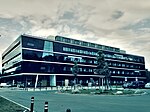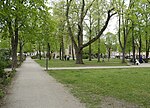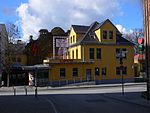Erlangen

Erlangen (German pronunciation: [ˈɛɐ̯laŋən] (listen); Mainfränkisch: Erlang, Bavarian: Erlanga), is a Middle Franconian city in Bavaria, Germany. It is the seat of the administrative district Erlangen-Höchstadt (former administrative district Erlangen), and with 116,062 inhabitants (as of 30 March 2022), it is the smallest of the eight major cities (Großstadt) in Bavaria. The number of inhabitants exceeded the threshold of 100,000 in 1974, making Erlangen a major city according to the statistical definition officially used in Germany. Together with Nuremberg, Fürth, and Schwabach, Erlangen forms one of the three metropolises in Bavaria. With the surrounding area, these cities form the European Metropolitan Region of Nuremberg, one of 11 metropolitan areas in Germany. The cities of Nuremberg, Fürth, and Erlangen also form a triangle on a map, which represents the heartland of the Nuremberg conurbation. An element of the city that goes back a long way in history, but is still noticeable, is the settlement of Huguenots after the withdrawal of the Edict of Nantes in 1685. Today, many aspects of daily life in the city are dominated by the Friedrich Alexander University Erlangen-Nuremberg and the Siemens technology group.
Excerpt from the Wikipedia article Erlangen (License: CC BY-SA 3.0, Authors, Images).Erlangen
Badstraße, Erlangen Sebaldussiedlung
Geographical coordinates (GPS) Address Nearby Places Show on map
Geographical coordinates (GPS)
| Latitude | Longitude |
|---|---|
| N 49.583333333333 ° | E 11.016666666667 ° |
Address
Badstraße 40
91052 Erlangen, Sebaldussiedlung
Bavaria, Germany
Open on Google Maps








